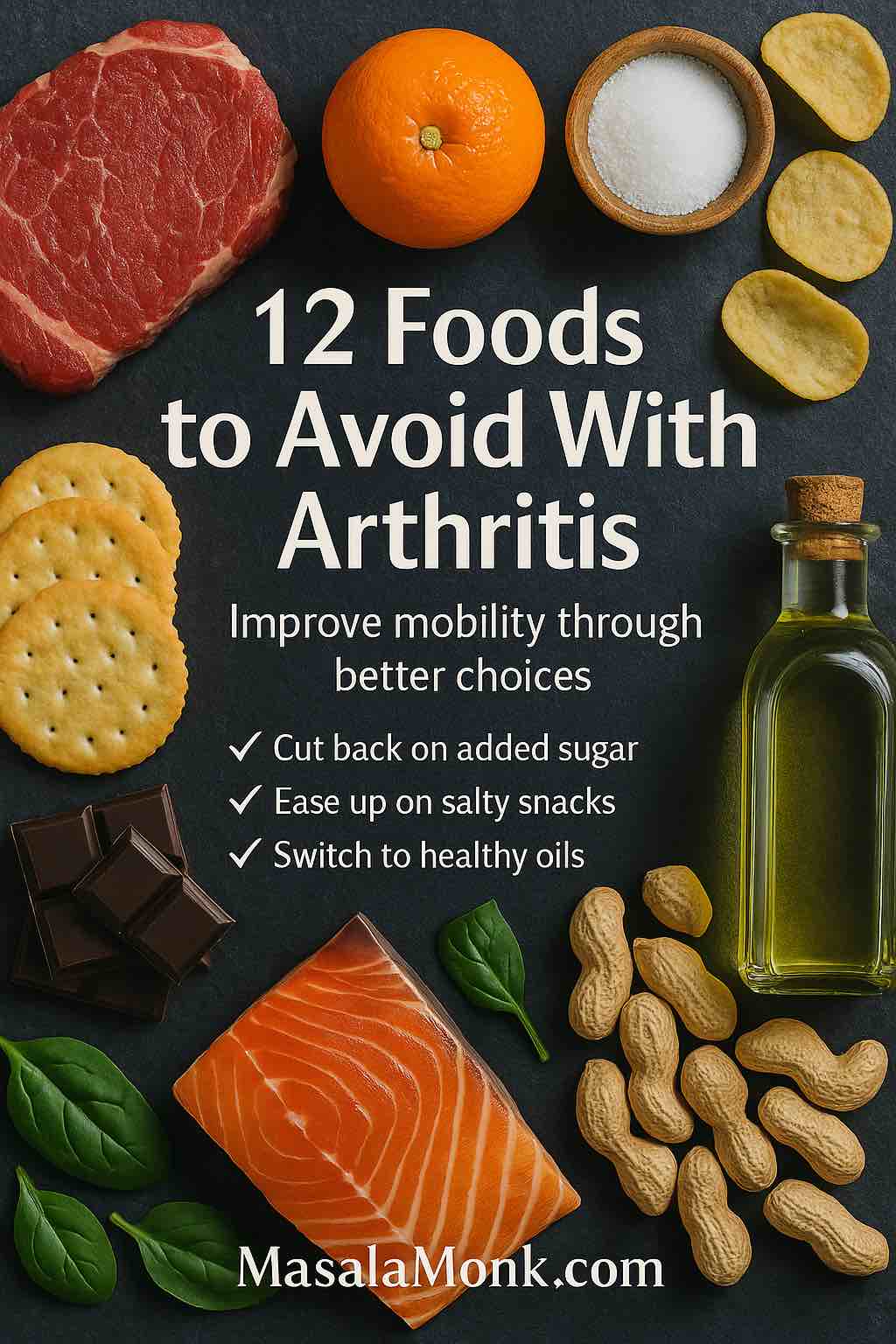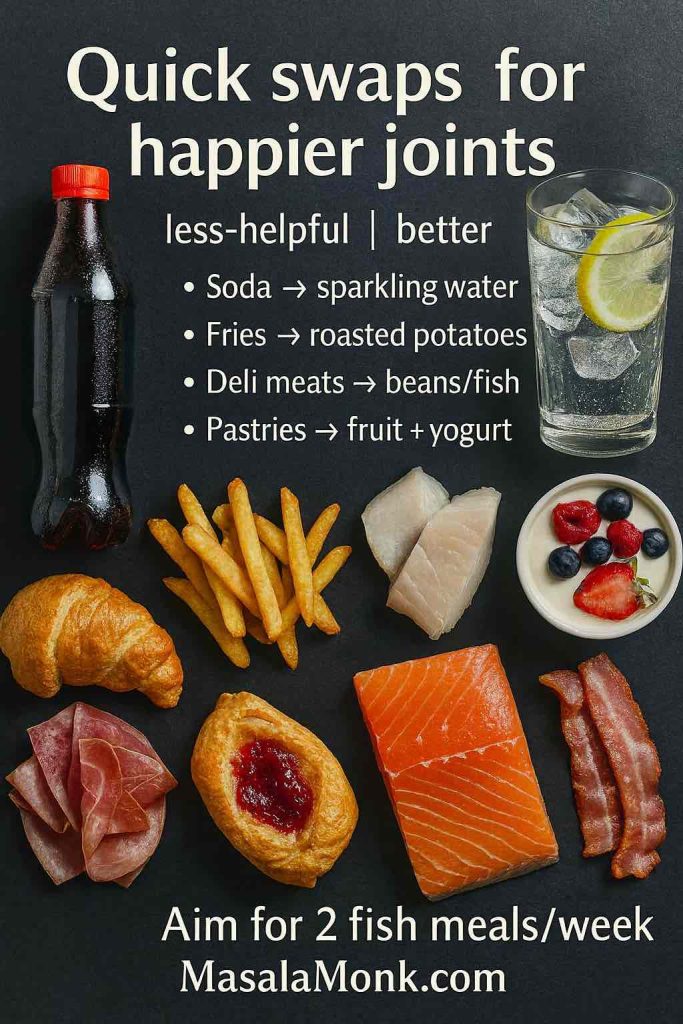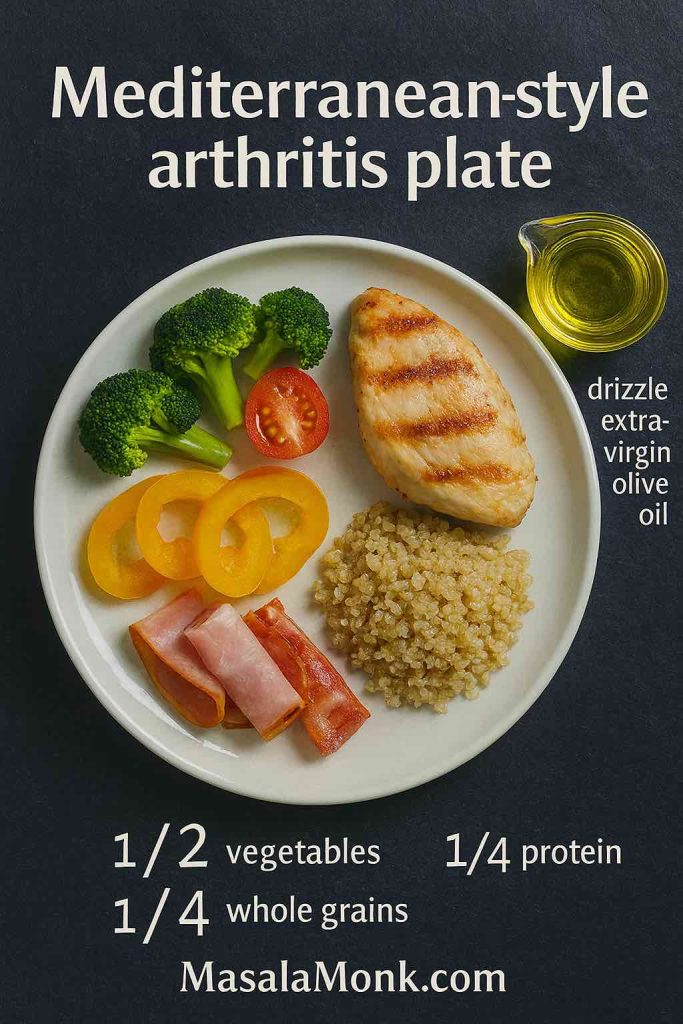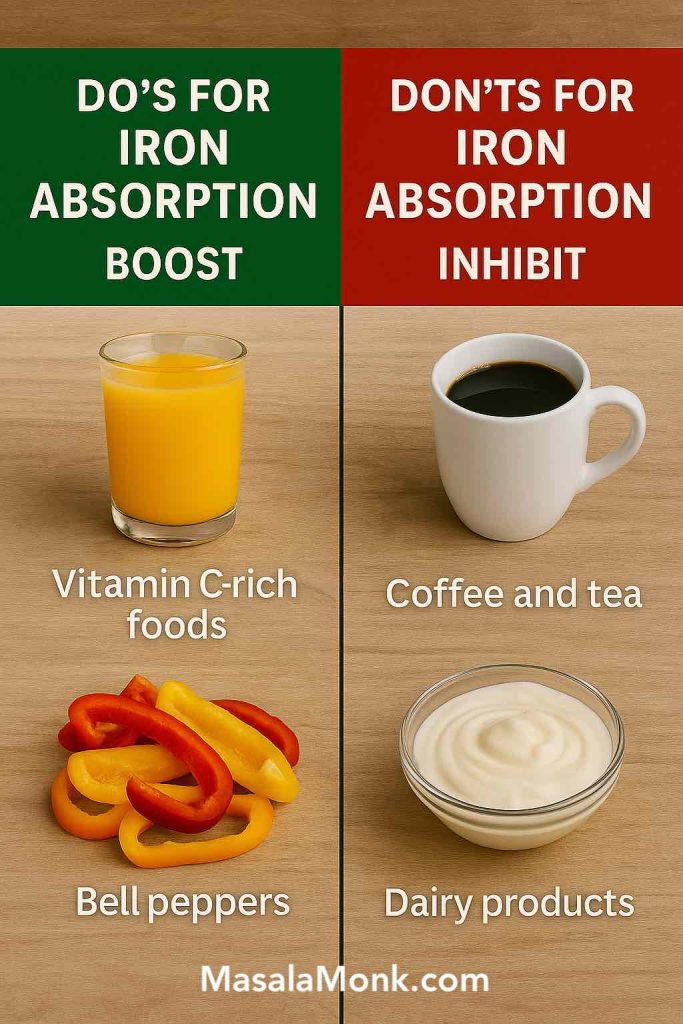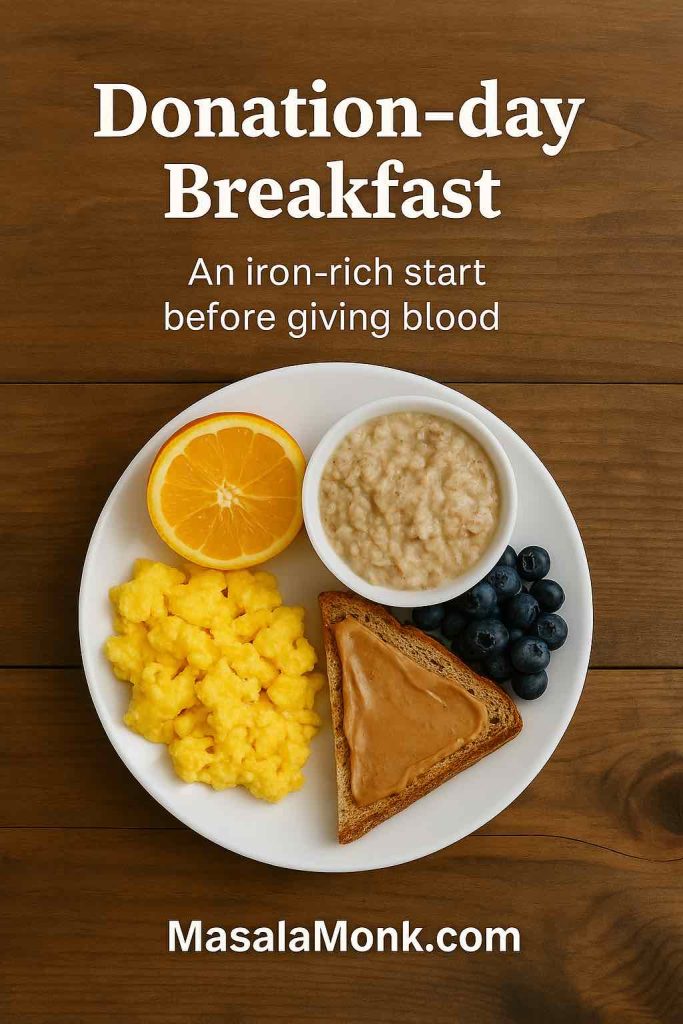
Coconut water cocktails are the simplest way to make your glass taste like holiday—without tipping it into dessert. They stay crisp and gently sweet; plus, because coconut water is naturally clean and a touch mineral, these drinks play beautifully with rum, tequila, vodka, gin, and even bourbon. Right from the first pour, coconut water cocktails soften sharp edges, brighten citrus, and keep every sip light on its feet. And yes, if you’ve heard people say “coconut juice,” that’s just another name for coconut water.
Why this approach makes sense. We start from classic templates—think the official Mojito spec and the official Margarita spec—then, instead of soda or a heavy mixer, we lengthen with chilled coconut water. As a result, the bones of the cocktail stay intact while the vibe shifts toward sunshine.
Also Read our post: The Ultimate Guide to Coconut Water: Benefits, Nutrition, and How to Choose the Best One.
How coconut water cocktails stay crisp (temperature, dilution, and balance)
First, keep everything colder than you think. Chilled bottles, fresh ice, and a gentle stir matter because highballs are mostly mixer. For a quick primer on why this works, see Punch’s guide to highball technique: easy ways to keep tall drinks lively. Likewise, notice how a simple highball often leans toward a 2:1 mixer-to-spirit ratio; Liquor.com’s whiskey highball method shows the idea we adapt here with coconut water.
Next, prefer unsweetened coconut water. Brands vary—some taste round and sweet, others cleaner and more mineral—so taste first, then adjust in the glass: a squeeze of lime for snap, a micro-pinch of sea salt for focus, or a teaspoon of simple syrup if your citrus runs sharp. If you like numbers, you can browse the USDA FoodData Central entries for typical calories and electrolytes (they do swing by brand). Also, to clear up a common mix-up early: coconut water isn’t coconut milk—they’re different ingredients with different jobs; here’s a plain-English explainer on the difference between coconut water and coconut milk.
Finally, because temperature dictates texture, pick ice on purpose. Big cubes melt slowly and keep flavors tight; crushed ice melts faster but screams “vacation.” If you want zero fade, freeze coconut water ice cubes and build right over them.
And while you are at it, do not forget to have a look at our post: Punch with Pineapple Juice: Guide & 9 Party-Perfect Recipes.
A reliable base for coconut water cocktails (and how to nudge it)
Start with this easy framework, then tweak to taste:
- Ratio that just works: 60 ml spirit to 120 ml chilled coconut water (a friendly 1:2). Stir gently over plenty of ice. If there’s fresh juice involved, shake briefly for chill and texture, then strain over new ice—over-shaking can mute coconut’s delicate aroma.
- Acid and lift: Add 10–25 ml lime (or lemon). If the drink turns too sharp, lengthen with another splash of coconut water instead of piling on sugar.
- A tiny sweetness toolbox: Many coconut water cocktails need no added sugar. However, if you want a touch more body, use 5–10 ml simple syrup—or make coconut-water simple syrup (equal parts sugar and coconut water warmed just to dissolve).
- Glassware that fits: Highball or Collins works best for these tall, easy sippers; if you’re sizing your home setup, this quick primer on Collins vs. highball glass sizing helps match pours to volumes.
- A little backstory for fun: Our lighter piña colada nods to Puerto Rican roots and Coco López’s game-changing cream of coconut—if you enjoy origin stories, this concise Piña Colada history is a neat read.
And if Piña Colada is your thing, our post on Piña Colada and its variants is a neat read.
Recipe 1: Rum & Coconut Water Highball
Style: tall, bright, two-minute build
Serves: 1 drink
Ingredients
- 60 ml white rum (2 oz)
- 120–150 ml chilled unsweetened coconut water (4–5 oz)
- 1 fresh lime wedge, plus a wheel for garnish
- Ice (big cubes for a cleaner sip; crushed for beach vibes)

How this coconut water cocktail comes together
First, fill a chilled highball with ice so the glass is properly cold.
Next, add the rum and immediately top with coconut water.
Then, squeeze the lime wedge over the drink, drop it in, and give exactly one gentle stir—just enough to marry, not to dilute.
Finally, taste and adjust: a tiny extra squeeze of lime for snap, or a splash more coconut water if you want a longer, lighter profile.
Why it works
Rum brings soft vanilla and sugarcane notes; meanwhile, coconut water contributes clean, mineral sweetness. Together, they deliver one of the most effortless coconut water cocktails—refreshing first, tropical second.
Variations
- Spiced Route: Swap white rum for spiced rum and add 2 dashes aromatic bitters; finish with an expressed orange peel.
- Pineapple Lift: Add 30 ml (1 oz) pineapple juice and 10 ml lime for a sunnier, fruit-forward twist.
- Coconut-Forward: Build over coconut water ice cubes so the flavor stays true right to the last sip.
Make-ahead
Stir together rum and coconut water in a small jug up to 2 hours ahead and refrigerate. However, add citrus and fresh ice only at serve time so the drink stays lively.
Serving note
Because this is a blueprint for many coconut water cocktails, you can scale it to a pitcher easily: keep the 1:2 spirit:coconut-water ratio, chill thoroughly, and, moreover, pass a bowl of lime wedges so guests can tune their glass.
If you’d like another rum path for later, this Watermelon Daiquiri keeps things bright and summery.
Recipe 2: Coconut Water Margarita
Style: classic shaken sour, stretched for sunshine
Serves: 1 drink
Ingredients
- 60 ml blanco tequila (2 oz)
- 25 ml fresh lime juice (¾ oz)
- 15 ml orange liqueur (½ oz)
- 60–90 ml chilled coconut water (2–3 oz), to taste
- Pinch of fine salt for half-rim (optional)
- Ice

Step-by-step with balance in mind
First, if you enjoy a salted rim, swipe a lime wedge around half the glass and dip in fine salt—this way you can choose each sip.
Meanwhile, add tequila, lime juice, orange liqueur, and 60 ml coconut water to a shaker. Fill with ice and shake hard for 10–12 seconds.
Then, strain over fresh ice into your prepared glass.
Finally, lengthen with up to 30 ml more coconut water if you prefer a lighter, porch-friendly profile. Garnish with a lime wheel.
Flavor notes
You keep the margarita’s classic snap and agave glow; however, coconut water smooths the mid-palate and leaves a clean, refreshing finish. Consequently, this is one of those coconut water cocktails that wins over “not-too-sweet” drinkers instantly.
Variations
- Highball Take: Build in a tall glass: 60 ml tequila, 20 ml lime, 15 ml orange liqueur, 120 ml coconut water. Stir gently; add a grapefruit wedge if you like.
- Tropical Glow: Shake in 30 ml (1 oz) pineapple juice for a sunny, beach-bar vibe.
- No Liqueur, Still Great: Skip the orange liqueur and replace with 10–15 ml simple syrup; the coconut water keeps everything soft and bright.
Make-ahead
Batch tequila + orange liqueur + coconut water in a bottle and chill for a few hours. However, hold the lime until the moment you shake—fresh citrus is the difference between “good” and “oh wow.”
Serving note
If you’re hosting, set out a tiny dish of sea salt and a plate of lime wheels. Guests can salt one side of their glass and, furthermore, choose exactly how bright they want each sip.
For a weekend project, try these watermelon margarita variations—fun, fresh, and easy to batch
Recipe 3: Coconut Water Mojito
Style: minty, refreshing, softly tropical
Serves: 1 drink
Ingredients
- 8–10 fresh mint leaves, plus a sprig for garnish
- 15 ml simple syrup (½ oz)
- 25 ml fresh lime juice (¾ oz)
- 45 ml white rum (1½ oz)
- 90–120 ml chilled coconut water (3–4 oz), to taste
- Crushed ice (or cubes if that’s what you have)

Gentle muddle, bright finish
First, in a shaker tin, gently press the mint with the simple syrup—just a light muddle to perfume, not shred.
Next, add lime juice, rum, and 90 ml coconut water. Fill with ice and shake briefly (5–6 seconds) to chill and wake the aromatics.
Then, pour into a tall glass over fresh crushed ice.
Finally, top with another splash of coconut water if you want it longer. Garnish with a mint sprig and a lime wheel.
Why it works
Replacing soda with coconut water keeps the mojito airy and bright while adding a whisper of natural sweetness. Among coconut water cocktails, this one shines because the mint sings and the finish stays crisp.
Variations
- Sparkling Finish: After step 3, add a short splash of plain seltzer for extra lift.
- Pineapple Garden: Shake in 30 ml (1 oz) pineapple juice for a fruit-forward riff that still drinks light.
- Refined-Sugar-Free: Swap simple syrup for 10–15 ml honey syrup (1:1) or a small splash of agave.
Make-ahead
Blend a quick mint syrup (equal parts sugar and water warmed to dissolve; add a handful of mint, steep 30 minutes, strain). With that in the fridge, mojitos become a one-minute operation: mint syrup + lime + rum + coconut water, shake, pour.
Serving note
Because crushed ice dilutes faster, taste halfway through and, if needed, add a tiny pinch of salt or a squeeze of lime to keep flavors vivid from first sip to last.
Hosting a mixed crowd? Point non-drinkers to these pineapple mojito mocktails—same mint-pineapple vibe, no alcohol.
Recipe 4: Vodka Coconut Cooler
Style: ultra-light, clean, endlessly sippable
Serves: 1 drink
Ingredients
- 45–60 ml vodka (1½–2 oz)
- 150 ml chilled unsweetened coconut water (5 oz)
- 10–15 ml fresh lime juice (⅓–½ oz), to taste
- Ice
- Optional garnish: cucumber slice or thin lime wheel
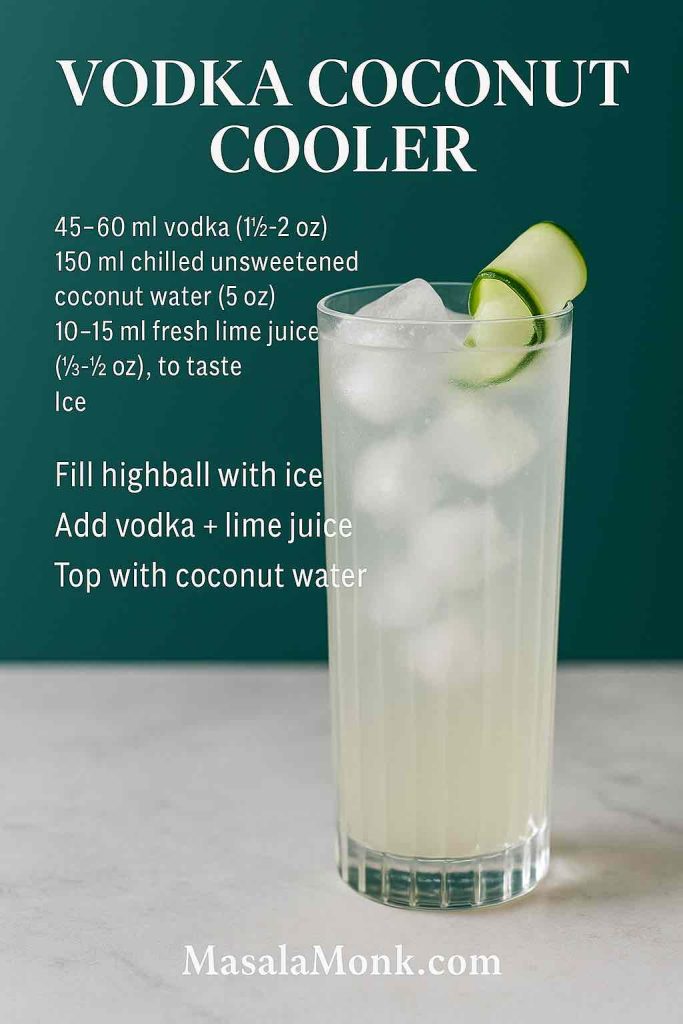
Smooth build, crisp finish
First, fill a tall highball with fresh ice so the drink stays bracingly cold.
Next, add the vodka and lime juice, and then top with coconut water.
After that, stir gently for 5–6 seconds—just enough to marry without over-diluting.
Finally, taste and adjust: a touch more lime for snap, or a splash more coconut water for a longer, lighter cooler.
Why it works
Among coconut water cocktails, this one is the minimalist. Vodka steps back, letting coconut water’s clean, mineral sweetness shine while lime keeps the edges bright.
Variations
- Cucumber Breeze: Muddle 2–3 thin cucumber slices in the glass first; then build as written for spa-day energy.
- Grapefruit Twist: Swap lime for 15 ml grapefruit juice and add 2 dashes grapefruit bitters for a gentle, bittersweet lift.
- Spritz Mode: Top the finished drink with a short splash of plain seltzer for extra sparkle.
Make-ahead
Stir vodka and coconut water in a bottle and chill for up to a day. However, add the lime only at serving so the cooler stays lively.
Serving note
Because this is one of the most approachable coconut water cocktails, it’s perfect for mixed crowds—simply lay out lime wedges so everyone can tune their glass.
Prefer vodka long-drinks? Here’s a Mango Vodka Cocktail (base + 7 variations) that stays tropical yet super clean.
Recipe 5: Gin & Coconut Highball (Gimlet-ish)
Style: botanical, bright, quietly tropical
Serves: 1 drink
Ingredients
- 60 ml dry gin (2 oz)
- 20 ml fresh lime juice (⅔ oz)
- 90–120 ml chilled coconut water (3–4 oz)
- Ice
- Optional bitters: 1–2 dashes orange or grapefruit bitters
- Garnish: mint sprig or a wide lime peel

Shake briefly, then lengthen
First, add gin, lime, and 90 ml coconut water to a shaker with ice.
Next, shake briefly (6–8 seconds) to chill and aerate without muting coconut’s delicate aroma.
Then, strain into an ice-filled highball and, if you prefer it longer, add another small splash of coconut water.
Finally, dot the top with a dash or two of citrus bitters, garnish, and serve.
Flavor notes
This lands squarely in the “refreshing yet grown-up” corner of coconut water cocktails. Gin’s botanicals get a soft-focus lens, lime brings zip, and coconut water smooths the finish.
Variations
- Pineapple Fizz: Shake in 30 ml pineapple juice; afterward, crown with a small splash of seltzer.
- Herbal Garden: Clap a basil leaf between your palms to wake it up, then tuck it alongside the mint for a greener aroma.
- Short & Strong (Rocks): Build 60 ml gin + 60–75 ml coconut water over a big cube; stir, garnish with expressed lime peel.
Make-ahead
Combine gin and coconut water in a small pitcher and chill for a few hours. However, shake each portion with fresh lime right before serving.
Serving note
If your gin leans juniper-heavy, a single dash of orange bitters rounds the edges beautifully; consequently, the drink reads polished rather than piney.
Also Read: Natural Pressure Regulator: How Coconut Water Can Help Manage High Blood Pressure
Recipe 6: Bourbon Coconut Refresher
Style: mellow, fragrant, surprisingly summery
Serves: 1 drink
Ingredients
- 60 ml bourbon (2 oz)
- 120 ml chilled coconut water (4 oz)
- 2 dashes aromatic bitters
- Expressed orange peel (plus extra for garnish)
- Ice

Stir, scent, and sip
First, fill a rocks or highball glass with ice.
Next, add the bourbon and coconut water, then stir 6–8 seconds to chill and integrate.
Afterward, add the bitters and express a wide strip of orange peel over the glass so the oils perfume the top; then drop it in.
Finally, taste and tweak: if it feels a touch sweet, squeeze a tiny wedge of lemon or add a micro pinch of salt to sharpen the profile.
Why it works
Bourbon’s caramel and vanilla lean into coconut’s gentle sweetness; meanwhile, bitters and orange oils keep the finish bright and tidy. It’s the sleeper hit of coconut water cocktails—unexpectedly summery, deeply sippable.
Variations
- Ginger Snap: Float 15–30 ml ginger ale on top for a gingery sparkle.
- Citrus Pivot: Swap the orange peel for lemon and add 5 ml lemon juice if you prefer a tangier edge.
- Island Old Fashioned (Short): Stir 60 ml bourbon, 10 ml coconut-water simple syrup, and 2 dashes bitters over a big cube; garnish with orange peel.
Make-ahead
Mix bourbon, coconut water, and bitters in a small bottle and chill for a couple of hours. Add the expressed peel only when pouring so the aroma stays vivid.
Serving note
Because this reads softer than a whiskey-forward sipper, it’s a smart bridge for friends who “don’t usually drink bourbon” but love tall, easy coconut water cocktails.
Talking about Coconut water, do read Spice Up Your Electrolyte Game: 5 Refreshing Recipes with Cardamom, Cloves, and Coconut Water.
Recipe 7: Lighter Piña Colada (with Coconut Water)
Style: breezy, not-too-sweet, blender optional
Serves: 1 drink
Ingredients
- 60 ml white rum (2 oz)
- 90 ml pineapple juice (3 oz)
- 90 ml chilled coconut water (3 oz)
- 15 ml coconut cream (optional, for extra body)
- Ice
- Garnish: pineapple wedge or fronds
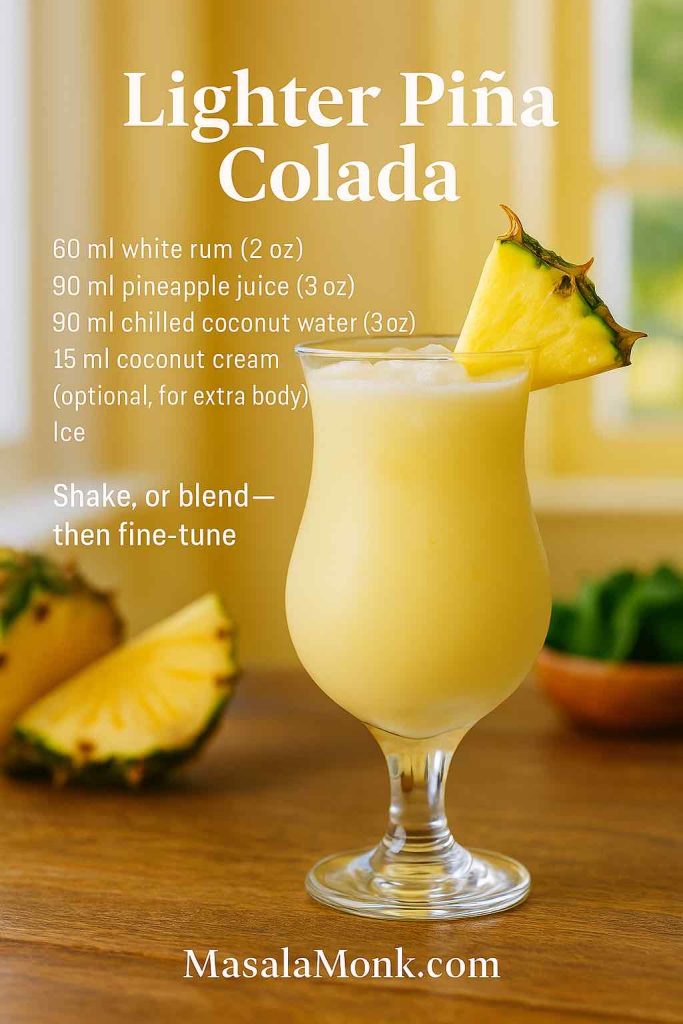
Shake, or blend—then fine-tune
First, decide on texture: shaken is lighter, while blended is beach-bar creamy.
Next, for the shaken version, add rum, pineapple juice, coconut water, and coconut cream (if using) to a shaker with ice; then shake hard for 12–15 seconds until frosty.
Afterward, strain into a chilled tall glass over fresh ice; subsequently, taste and adjust with a tiny squeeze of lime for lift or a splash more coconut water for length.
Alternatively, for the blended version, add everything to a blender with 1 cup of ice and blend just until smooth—no longer, otherwise the flavors can mute.
Finally, garnish with pineapple and serve immediately so the aromatics stay vivid.
Why it works
Classic coladas can be lush; however, this lighter take relies on coconut water to stretch flavor without adding heaviness. Consequently, you get a sunny, refreshing sip that still reads as a colada—one of the friendliest coconut water cocktails for warm afternoons.
Variations
- Gold-Rum Glow: Swap half the white rum for gold rum to add caramel warmth.
- Citrus Snap: Add 10 ml lime juice if your pineapple is very sweet; conversely, skip it if the fruit is tart.
- Colada Spritz: Shake the lighter version and, afterward, crown with a short splash of plain seltzer for sparkle.
Make-ahead
Pre-chill pineapple juice and coconut water together; nevertheless, add rum and any coconut cream only at serving, which keeps texture lively.
Serving note
Because this recipe skews sessionable, it’s excellent for mixed groups discovering coconut water cocktails—offer lime wedges so guests can tune sweetness versus brightness.
While still on Amazing Coconut water, have a look at The Power of Coconut Water: Unpacking the Health Benefits.
Recipe 8: Coconut Seltzer Spritz (Rum or Tequila)
Style: sparkling, ultra-refreshing, low effort
Serves: 1 drink
Ingredients
- 45 ml white rum or blanco tequila (1½ oz)
- 60 ml chilled coconut water (2 oz)
- 120 ml coconut-flavored seltzer or plain seltzer (4 oz)
- 10–15 ml fresh lime juice (⅓–½ oz), to taste
- Ice
- Garnish: lime wheel; optional mint sprig
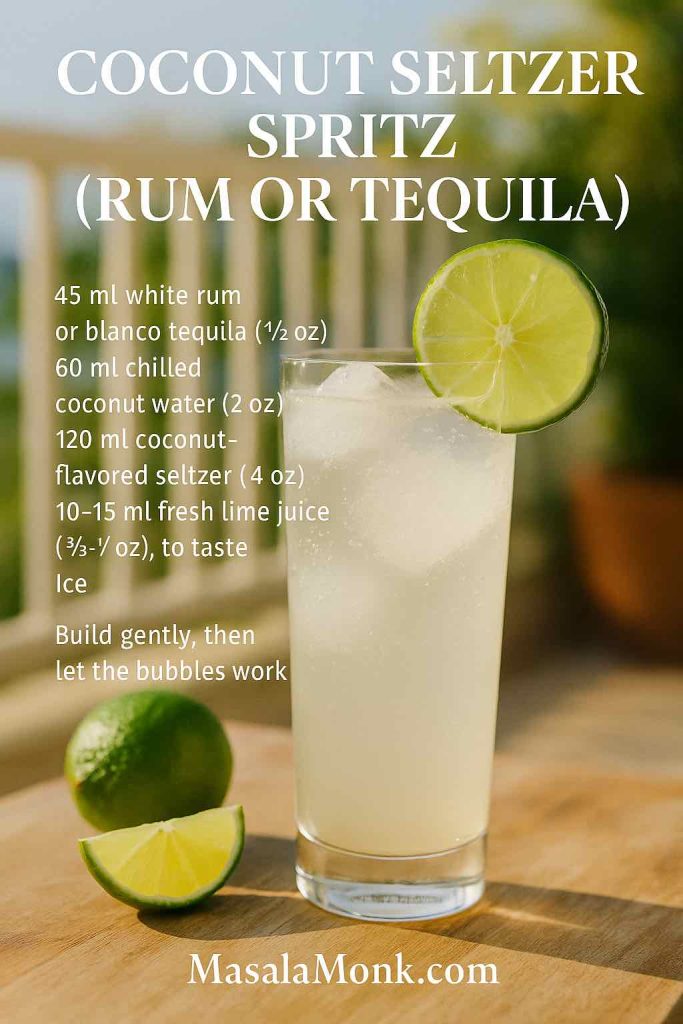
Build gently, then let the bubbles work
First, fill a tall glass with ice so everything starts truly cold.
Next, add the rum or tequila and the lime juice; then pour in the coconut water.
After that, top with seltzer; subsequently, give a brief, delicate stir so you don’t knock out the bubbles.
Finally, garnish and sip; if you prefer it softer, add a final whisper of coconut water.
Flavor notes
This sits squarely in the spritz family of coconut water cocktails—bright, buoyant, and charmingly simple. Meanwhile, the bubbles carry coconut aroma upward, so each nose of the glass feels tropical before you even taste.
Variations
- Grapefruit Lane: Swap lime for 15 ml grapefruit juice and add a micro-pinch of sea salt; consequently, the finish snaps.
- Pineapple Wink: Add 15–30 ml pineapple juice before topping with seltzer for a fruit-forward spritz.
- Zero-Fuss Pitcher: Combine spirit and coconut water in advance; thereafter, add lime and seltzer in the glass so carbonation stays lively.
Make-ahead
Batch spirit + coconut water and chill for up to 3 hours; however, never add seltzer early, or the spritz will fall flat.
Serving note
Because the drink is feather-light, it’s a great “first round” when introducing friends to coconut water cocktails—especially on hot days.
You might also want to explore The Versatility of Coconut Water: 5 Creative Recipes Beyond the Glass.
Recipe 9: Tequila–Coconut–Lime Highball
Style: simple build, crisp and grassy with a soft landing
Serves: 1 drink
Ingredients
- 60 ml blanco tequila (2 oz)
- 10–20 ml fresh lime juice (⅓–⅔ oz), to taste
- 120–150 ml chilled coconut water (4–5 oz)
- Ice
- Optional garnish: lime wheel or thin cucumber slice

Build, balance, and brighten
First, add tequila and lime to an ice-filled highball.
Next, top with coconut water and stir gently for 5–6 seconds.
Then, taste thoughtfully: add a splash more coconut water for length or a few extra drops of lime for snap; moreover, a micro-pinch of sea salt can knit flavors together.
Finally, garnish simply and serve while well chilled.
Why it works
Tequila’s grassy, peppery edge meets coconut’s mellow sweetness, and, as a result, the highball finishes clean rather than sharp. Consequently, this has become a staple among our coconut water cocktails—it’s as easy as it is satisfying.
Variations
- Paloma-ish: Replace half the coconut water with grapefruit soda or add 60–90 ml coconut seltzer; afterward, taste and add a pinch of salt.
- Herbal Breeze: Clap a cilantro sprig or basil leaf between your palms to release aroma, then tuck it in.
- Short & Strong: Build 60 ml tequila + 75–90 ml coconut water over a big rock; stir, garnish with expressed lime peel.
Make-ahead
Stir tequila and coconut water together and chill; nevertheless, add fresh lime in the glass so the drink stays bright.
Serving note
This highball excels with tacos and salty snacks; furthermore, its easy balance makes it a gateway coconut water cocktail for tequila lovers.
And for using this Elixir or Coconut water beyond cocktails, do read Coconut Water for Wellness: 5 Refreshing Recipes for Recovery and Weight Loss
Recipe 10: Rum–Pineapple–Coconut Lime Highball
Style: bright, sunny, crowd-pleaser
Serves: 1 drink
Ingredients
- 45 ml white rum (1½ oz)
- 30 ml pineapple juice (1 oz)
- 10 ml fresh lime juice (⅓ oz)
- 120 ml chilled coconut water (4 oz)
- Ice
- Garnish: lime wheel or pineapple leaf
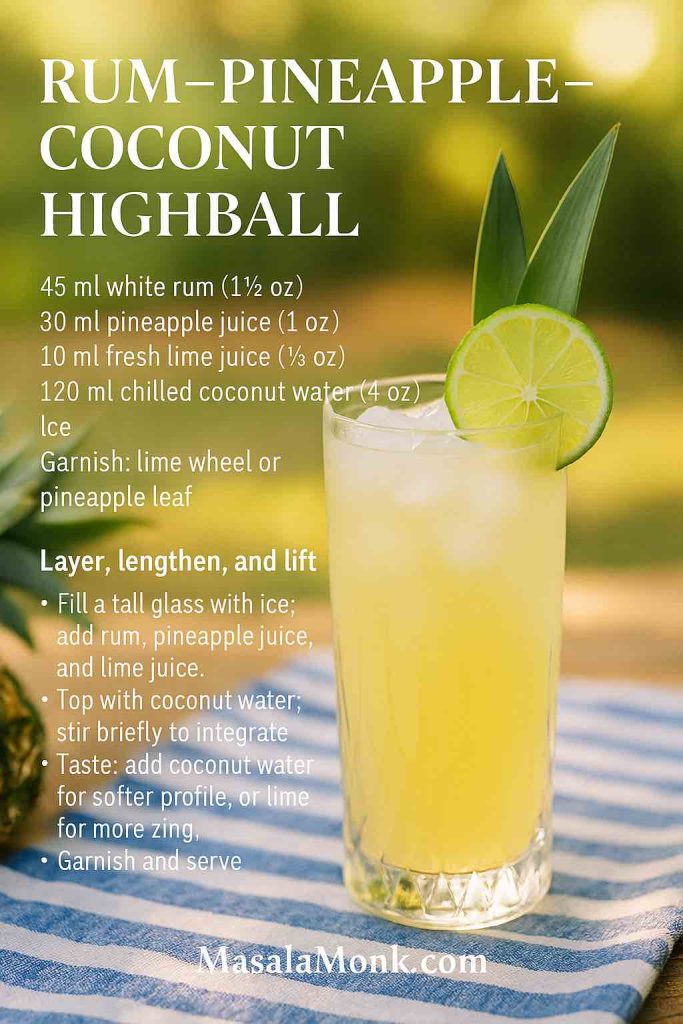
Layer, lengthen, and lift
First, fill a tall glass with ice; then add rum, pineapple juice, and lime juice.
Next, top with coconut water and stir briefly to integrate.
Afterward, taste; if you want more zing, add a tiny extra squeeze of lime, whereas if you want a softer profile, add another splash of coconut water.
Finally, garnish and serve immediately so the pineapple aromatics don’t fade.
Flavor notes
This is vacation-in-a-glass—yet, thanks to coconut water, it stays light on its feet. Moreover, the pineapple brightens while lime sharpens, creating one of the most crowd-friendly coconut water cocktails on the menu.
Variations
- Gold-Rum Depth: Swap half the white rum for gold rum to add toffee notes.
- Bitters Pop: Add 1–2 dashes aromatic bitters for a polished finish.
- Sparkling Twist: Top with plain seltzer for extra lift, especially on hot afternoons.
Make-ahead
Pre-combine pineapple juice and coconut water in a chilled bottle; however, add rum and lime to order so the citrus stays vivid.
Serving note
Because the flavors read familiar and friendly, this is the highball you can hand to almost anyone exploring coconut water cocktails for the first time.
Quick Fixes When a Drink Tastes “Almost Right”
Even great coconut water cocktails sometimes need a tiny nudge. Therefore, try one tweak at a time and taste after each change.
- Too tart? Add a splash of coconut water before you reach for sugar; it lengthens and softens without masking flavor.
- Too sweet? Add 5–10 ml fresh lime or a micro pinch of sea salt; both sharpen edges instantly.
- Too flat? Stir once more with fresh ice or add a dash of bitters (aromatic for rum/bourbon; citrus for gin/tequila).
- Too strong? Lengthen with 30–60 ml coconut water and, if needed, one small squeeze of lime to keep it lively.
- Not coconutty enough? Build over coconut water ice cubes next time; the flavor won’t fade as the glass warms.
Smart Swaps & Pantry Shortcuts
Because real life isn’t a bar back, these swaps keep momentum.
- Citrus: Lemon works where lime is called for; start with a little less, then adjust.
- Sweeteners: If you’re out of simple syrup, dissolve 1 tsp sugar directly in the glass or use agave/honey syrup (1:1).
- Rum choices: White keeps things crisp; gold adds soft caramel; spiced brings baking-spice warmth.
- Tequila & gin: Blanco tequila reads grassy and bright; London dry gin is classic, but a lighter, citrus-forward gin can be lovely, too.
- Seltzer: When you want bubbles, plain seltzer is neutral; coconut-flavored seltzer adds aroma without weight.
Make-Ahead & Hosting (Crowd-Friendly, Still Fresh)
For parties, coconut water cocktails shine because they’re easy to batch—just keep the bright parts last.
- Pitcher rule: Pre-mix spirit + coconut water up to 3 hours ahead and chill deeply. Add citrus just before serving.
- Scale without math: Keep the 1:2 spirit:coconut water ratio. For 8 drinks, that’s ~480 ml spirit + ~960 ml coconut water.
- Self-tuning station: Set out lime wedges, mint, a tiny bottle of simple syrup, and bitters so guests can “tune” sweetness and snap.
- Ice plan: Start with coconut water cubes for the first round, then switch to regular ice so you don’t run out.
- Glassware: Highballs for long sippers; rocks for shorter, stronger serves—label pitchers so nobody guesses.
For an inclusive pitcher, keep a zero-proof option like this best margarita mocktail (step-by-step) alongside the spirits; and for low-carb guests, this quick keto mocktails guide has easy swaps.
Photo & Garnish Cheat Sheet (Fast but Pretty)
A little garnish reads as care, not fuss.
- Rum highballs: Lime wheel + optional mint.
- Tequila & lime builds: Lime wheel or thin cucumber slice.
- Gin long drinks: Mint sprig or wide lime peel; a dash of citrus bitters looks gorgeous.
- Bourbon refresher: Expressed orange peel—shine it over the glass so the oils sparkle.
- Piña colada (lighter): Pineapple wedge or a couple of fronds; crushed ice = instant vacation.
Storage Notes (Because You’ll Make More Tomorrow)
- Simple syrup: Fridge, up to 2 weeks.
- Coconut-water simple syrup: Fridge, 1–2 weeks; label it so you remember which is which.
- Mint syrup: Fridge, 1 week; keep it bright by adding the mint after the syrup cools, then strain.
- Opened coconut water: Keep chilled and use within 2–3 days for best flavor.
The Last Sip
In the end, coconut water cocktails are about ease: a cold glass, a friendly 1:2 ratio, and a little fresh citrus. Because the mixer is light and mineral, the drinks feel sunny rather than heavy; because the steps are simple, they’re weeknight-friendly as well as party-proof. So chill your bottles, pile on the ice, and pour like you’re on holiday—even if the “beach” is your balcony. Cheers.
FAQs
1) What alcohol mixes best with coconut water for easy coconut water cocktails?
Rum is the most classic; however, tequila, vodka, and gin all shine, and even bourbon works beautifully. Start with a simple 1:2 ratio (60 ml spirit to 120 ml chilled coconut water), then add 10–20 ml fresh lime for lift.
2) Can I make a margarita with coconut water, and how is it different?
Yes—shake tequila, lime, and orange liqueur, then lengthen with coconut water. Consequently, you keep the margarita’s snap but get a smoother, lighter finish that reads super refreshing.
3) How do I build a mojito-style drink using coconut water instead of soda?
Gently muddle mint with a little syrup, add lime and rum, then top with coconut water and crushed ice. Meanwhile, a tiny pinch of sea salt wakes up the mint and keeps the sweetness in check.
4) Do vodka and coconut water actually work together?
Absolutely. Vodka steps back while coconut water and citrus do the talking. For weeknight-friendly coconut water cocktails, it’s one of the cleanest, most sippable combos—especially with a cucumber slice.
5) What about gin—won’t botanicals clash with coconut water?
Not really. In fact, gin’s botanicals get a soft-focus finish. Shake briefly with lime, then lengthen with coconut water; additionally, a dash of orange or grapefruit bitters makes the drink feel polished.
6) Is bourbon too heavy for coconut water cocktails?
Surprisingly, no. Bourbon’s caramel and vanilla meet coconut’s gentle sweetness; then bitters and an expressed orange peel keep things bright. If it reads sweet, add a micro pinch of salt or a squeeze of lemon.
7) Can I make a lighter piña colada using coconut water?
Yes—use pineapple juice, rum, and coconut water (with a spoon of coconut cream only if you want extra body). Consequently, you get the beachy vibe without the weight, and a squeeze of lime keeps it lively.
8) How can I use seltzer or LaCroix with coconut water in cocktails?
Build spirit + lime + coconut water, then top with coconut seltzer (or plain seltzer). Because the bubbles carry aroma, the spritz drinks extra bright—great for first rounds and hot afternoons.
9) What’s the best simple ratio for batching coconut water cocktails for a party?
Keep it math-free: 1 part spirit to 2 parts chilled coconut water in a pitcher. Moreover, add citrus right before serving so the mix stays vivid; let guests adjust with lime wedges, syrup, and bitters.
10) My drink tastes off—too tart, too sweet, or too flat. Quick fixes?
Too tart? Add a splash of coconut water. Too sweet? Add 5–10 ml lime or a tiny pinch of salt. Too flat? Fresh ice and one dash of bitters (aromatic for rum/bourbon; citrus for gin/tequila) bring it back.
11) Is “coconut juice” the same as coconut water in cocktail recipes?
Yes—many people say “coconut juice,” but they mean coconut water. However, it is not the same as coconut milk (richer and opaque) or cream of coconut (sweetened and thick).
12) Any quick ways to make coconut flavor last to the final sip?
Definitely. Freeze coconut water ice cubes and build over them; alternatively, make a fast coconut-water simple syrup (equal parts sugar and coconut water warmed just to dissolve). Consequently, the finish stays coconutty, not watery.

